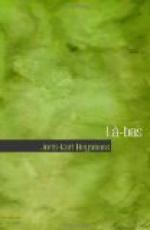“In this is what claims to be the recipe for the philosopher’s stone, for the grand quintessential and tinctural essence. The figures are not precisely clear,” he said to himself, as he ran his eye over the pen drawings, retouched in colour, representing, under the title of “The chemical coitus” various bottles and flasks each containing a liquid and imprisoning an allegorical creature. A green lion, with a crescent moon over him, hung head downward. Doves were trying to fly out through the neck of the bottle or to peck a way through the bottom. The liquid was black and undulated with waves of carmine and gold, or white and granulated with dots of ink, which sometimes took the shape of a frog or a star. Sometimes the liquid was milky and troubled, sometimes flames rose from it as if there were a film of alcohol over the surface.
Eliphas Levi explained the symbolism of these bottled volatiles as fully as he cared to, but abstained from giving the famous recipe for the grand magisterium. He was keeping up the pleasantry of his other books, in which, beginning with an air of solemnity, he affirmed his intention of unveiling the old arcana, and, when the time came to fulfil his promise, begged the question, alleging the excuse that he would perish if he betrayed such burning secrets. The same excuse, which had done duty through the ages, served in masking the perfect ignorance of the cheap occultists of the present day.
“As a matter of fact, the ‘great work’ is simple,” said Durtal to himself, folding up the manuscript of Nicolas Flamel. “The hermetic philosophers discovered—and modern science, after long evading the issue, no longer denies—that the metals are compounds, and that their components are identical. They vary from each other according to the different proportions of their elements. With the aid of an agent which will displace these proportions one may transmute mercury, for example, into silver, and lead into gold.
“And this agent is the philosopher’s stone: mercury—not the vulgar mercury, which to the alchemists was but an aborted metallic sperm—but the philosophers’ mercury, called also the green lion, the serpent, the milk of the Virgin, the pontic water.
“Only the recipe for this mercury, or stone of the sages, has ever been revealed—and it is this that the philosophers of the Middle Ages, the Renaissance, all centuries, including our own, have sought so frantically.
“And in what has it not been sought?” said Durtal, thumbing his notes. “In arsenic, in ordinary mercury, tin, salts of vitriol, saltpetre and nitre; in the juices of spurge, poppy, and purslane; in the bellies of starved toads; in human urine, in the menstrual fluid and the milk of women.”
Now Gilles de Rais must have been completely baffled. Alone at Tiffauges, without the aid of initiates, he was incapable of making fruitful experiments. At that time Paris was the centre of the hermetic science in France. The alchemists gathered under the vaults of Notre Dame and studied the hieroglyphics which Nicolas Flamel, before he died, had written on the walls of the charnal Des Innocents and on the portal of Saint Jacques de la Boucherie, describing cabalistically the preparation of the famous stone.




